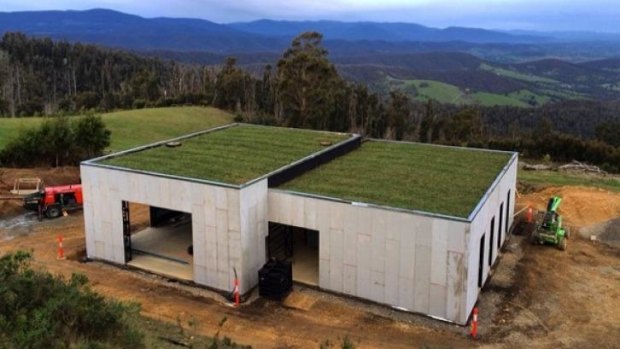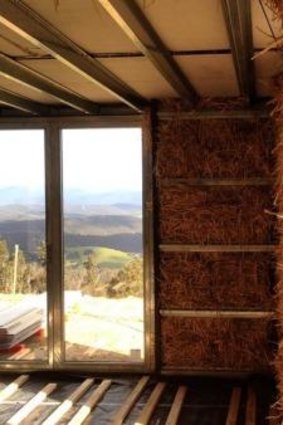By Ray Edgar
Two years ago Joost Bakker tried to burn down a house he designed for chef Shannon Bennett. CSIRO helped ignite it. As spectacular as the video record indicates, it's an act of research rather than pyromania. Their aim was to simulate the worst bushfire conditions for a house that would eventually be built in the Otways.
"This thing was immersed in flame for two minutes, which is the maximum amount of time a flame front could take to burn past if it was parked in the worst bit of bush you could find in Victoria," says CSIRO's Justin Leonard, who oversaw the test at its special facility in NSW. At its peak, temperatures reached more than 1000 degrees Celsius.

Green: The Bakker house features a grass roof, the soil of which helps insulate the building.
When a bushfire claims a house it effectively involves two fires – the bushfire and the house fire. But it's the house fire that does the most damage, according to Leonard.
"The fuel load of a house – the house and its contents – is potentially five to 10 times higher than the fuel load of the forest," says Leonard, who was an expert witness at the 2009 Black Saturday Royal Commission.

Packing: Straw bales that fill wall and ceiling cavities can deny a fire the oxygen it needs.
The objective, then, is to ensure the house isn't breached.
"Where the roof joins the main house is where it's quite vulnerable," says Bakker, a self-described artist who has initiated a number of sustainable projects, including the waste-free Greenhouse by Joost pop-up restaurant. "Most houses have oxygen in the roof cavity. That's what a fire is desperately looking for. There might be an opening or gap or steel flashing or corrugated iron that will buckle away and that will give the fire the oxygen it needs in the roof cavity and that's when a fire takes hold."
In Bakker's house, lightweight steel replaced a timber frame. Straw bales, inspired by European designs, provided the insulation.
"The Austrian government rates a straw bale house as a one-and-a-half day burn time," says Bakker. "Whereas a conventional house is 90 minutes."
Clad in five types of magnesium oxide of varying cost (to see if price discrepancies had any effect on this wonder product – it didn't, he says), his house had a grass roof whose soil helped insulate the building. Fireproof windows were also installed. The house survived.
Bakker approached Leonard for advice in 2005 because the local council wouldn't allow him to build in a high fire zone. Since the Royal Commission, restrictions have only become tighter.
To satisfy those building code requirements is often very costly, says Bakker. While he effectively designed his house as a bunker, not everyone can afford it on a house-sized scale.
As the Climate Council warns of a "major" bushfire season this summer, the State Government has announced a new campaign to "Leave and live".
While no one would argue life is more valuable than property, a bunker is seen by many as a way to stay and survive. "It's the hot topic in the current suite of planning reforms," says Leonard.
"Putting in a bunker is a hell of a lot cheaper than trying to make the house fire-resistant," says Bakker. "You can buy bunkers for under $10,000."
But it's a slow process for those still waiting to rebuild five years after Black Saturday. NASH standard steel-frame constructions for bushfire areas received national construction code approval just last month (and will take effect in May 2015). Meanwhile in July this year bunkers were added to the planning scheme, reducing construction requirements.
Activist Kate Cotter, who represents a lobby group of 5500 affected by the State Government's bushfire management overlay, welcomes any technological advances. "We now have three approved [types of] bunkers in Victoria and about to get a fourth," she says. "Building standards have radically improved. That situation wasn't there when they were setting the policy back in 2010. It's understandable that it evolves [slowly], but the community is suffering."
Stymied by bureaucracy that isn't satisfied with meeting Australian building codes, bunkers have certainly helped broker the stalemate.
Still it's not a matter of dropping a bunker anywhere. "The path from the house to the bunker is absolutely critical," says Leonard. "You can't do enough to design that to be extremely well sheltered and safe. The best thing would be a completely protected tunnel or corridor between your house and the bunker that is not combustible."
"There's a design solution for nearly every location," says Leonard. "I wouldn't like to see people discouraged from living in the bush."